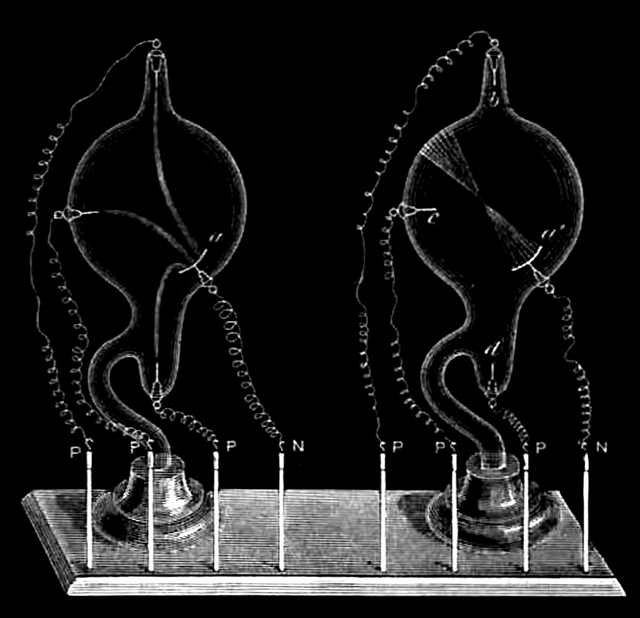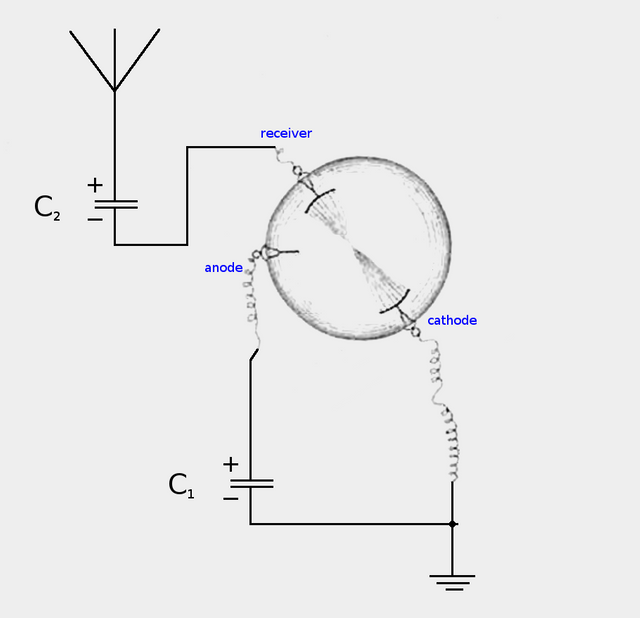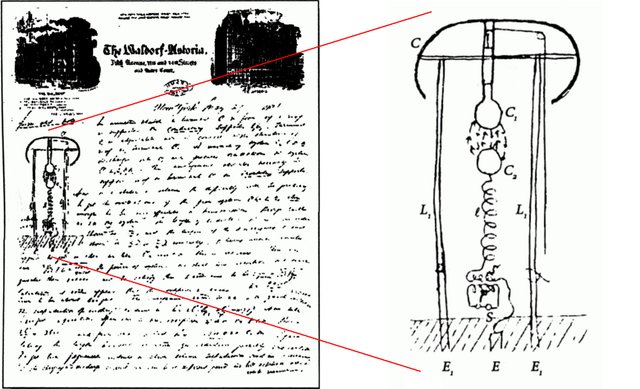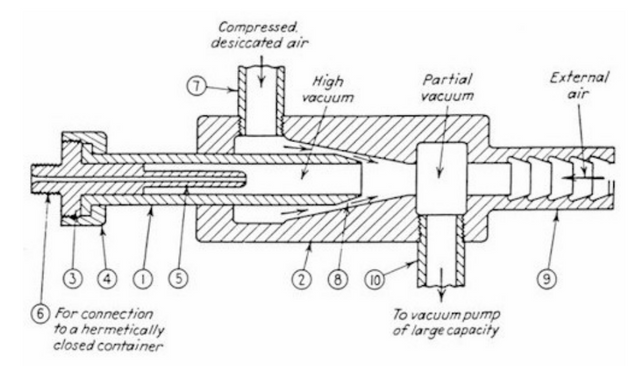Tesla’s Self Acting Engine and the vacuum tube for ANY voltage, no matter how high
We have now build a machine based on the works of Tesla and found that sometimes it creates an excess current. That is, more current comes out than we put in.
There are now two problems we need to solve:
- one, we want it to constantly produce this excess current and
- two, we want the current and the potential thereof high enough so that we produce excess energy.
If we can accomplish this, then my project is completed and we have proven that Tesla was indeed the genius way ahead of his time that many believe him to be.
Also, we then have opened up a new view on the world around us, one that will lead to many more valuable scientific discoveries.
To proceed we first need to find what line of reasoning led Tesla to designing this machine.
What was his theory behind it?
Of course, this can never be established with 100% certainty, but based on historical evidence and the works that Tesla left us, I am convinced that he wanted us to find his “secret” and that we can at the very least make an educated guess.
In Tesla’s lecture of February 3rd, 1892 “Experiments with Alternate Currents of High Potential and High Frequency” Tesla says about Crookes:
When I was at college, a good time ago; I read, in a translation (for then I was not familiar with you magnificent language), the description of his experiments on radiant matter. I read it only once in my life—that time—yet every detail about that charming work I can remember this day. Few are the books, let me say, which can make such an impression upon the mind of a student.
While examining Tesla’s lectures and patents, we notice that it looks very much like an extension of Crookes work, and Tesla does mention him a number of times as a source of inspiration.
Sir William Crookes in turn was inspired by Faraday who believed there should be a 4th state of matter (beyond solid, liquid and gaseous) which he called “radiant”.
Crookes reasoned that phases of matter differ mostly in density, and so by reducing the pressure of a gas we may find this 4th state. He started experimenting with highly evacuated tubes, passing electric currents through them and found some truly remarkable facts.
He concluded that the negative electrode (cathode) would emit rays perpendicular to its surface. (later he found that also the anode emitted some sort of rays)
He assumed that these rays were the radiant state of the residual gasses inside the tube.

These rays travel in straight lines and that fact in particular must have triggered a spark in Tesla’s mind.
In this picture you see that in a moderately exhausted tube (left) the electricity flows from the cathode to the anode, while in a highly evacuated tube (right) we see rays emitted from the cathode that travel in straight lines.
If these rays have electric properties – which was quickly established – then we can build something along the lines Tesla describes in his June 1900 article “The Problem of Increasing Human Energy:
This we could do by placing in the lake a tank, and pumping all the water out of the latter. We know, then, that the water, if allowed to flow back into the tank, would, theoretically, be able to perform exactly the same amount of work which was used in pumping it out, but not a bit more.
---//---
But let us reflect a moment. Heat, though following certain general laws of mechanics, like a fluid, is not such; it is energy which may be converted into other forms of energy as it passes from a high to a low level. To make our mechanical analogy complete and true, we must, therefore, assume that the water, in its passage into the tank, is converted into something else, which may be taken out of it without using any, or by using very little, power. For example, if heat be represented in this analogue by the water of the lake, the oxygen and hydrogen composing the water may illustrate other forms of energy into which the heat is transformed in passing from hot to cold. If the process of heat transformation were absolutely perfect, no heat at all would arrive at the low level, since all of it would be converted into other forms of energy. Corresponding to this ideal case, all the water flowing into the tank would be decomposed into oxygen and hydrogen before reaching the bottom, and the result would be that water would continually flow in, and yet the tank would remain entirely empty, the gases formed escaping. We would thus produce, by expending initially a certain amount of work to create a sink for the heat or, respectively, the water to flow in, a condition enabling us to get any amount of energy without further effort.
In the image from Crookes lecture we see the anode attracting electricity from the cathode but once it escapes the metal it continues in a straight line never arriving at the anode.
An initial positive charge on the anode would attract negative charge from the cathode, but once this charge escapes the metal of the electrode it is converted into some ray that will never reach nor neutralize the positive charge that attracted it.
There are very few processes known that could match Tesla’s analogy but this is a perfect match.

Here you see this idea worked out. C1 is provided with an initial charge. This will attract negative charges from the cathode. But these will not arrive at the anode, they will go in a straight line and arrive in C2. Thus C1 and the vacuum tube act as a pump that moves negative charge from the cathode to the receiver.
The Earth provides a virtually unlimited source of negative charge while the atmosphere provides the positive charge as outlined in Tesla’s patent 685,957:
A simple way of supplying positive or negative electricity to the terminal is to connect the same either to an insulated conductor supported at some height in the atmosphere or to a grounded conductor, the former, as is well known, furnishing positive and the latter negative electricity.
Thus, in an ideal case, an initial charge on C1 will continue to charge C2 almost indefinitely, and we can periodically collect electricity from C2. In practice some charges will leak to the anode and gradually deplete C1. But in a well designed system we should be able to get from C2 many times our initial charge in C1.
This idea also matches the timeline that Tesla gave us in that same article. His self-acting engine would require 5 parts, two of which he had completed “at the close of 1894”
I was just beginning work on the third element, which together with the first two would give a refrigerating machine of exceptional efficiency and simplicity, when a misfortune befell me in the burning of my laboratory, which crippled my labours and delayed me.
After Tesla rebuilt his laboratory in 1895 he started experimenting with vacuum tubes to produce “powerful rays” until he left for Colorado Springs.
Upon his arrival in Colorado Springs we read in his notes of June 6th, 1899:
Arrangements with single terminal tube for production of powerful rays. There being practically no limit to the power of an oscillator, it is now the problem to work out a tube so that it can stand any desired pressure. The tubes worked with in New York were made either with aluminium caps or without same, but in both cases a limit was found so that but a small fraction of the obtainable e.m.f. was available. If of glass, the bottom would break through owing to streamers, and if an aluminium cap were employed there would be sparking to the cap.
Immersion in oil is inconvenient, likewise other expedients of this kind. The best results will probably be obtained in the end by static screening of the vulnerable parts of the tube. This idea was experimented upon in a number of ways. It is now proposed to test the arrangements indicated below:
In each case there would be an insulated body of capacity so arranged that the streamers can not manifest themselves. The capacity would be such as to bring about maximum rise of e.m.f. on the free terminal.
But this is the last time that he mentions vacuum tubes in his notes. Apparently he wanted to do some final experiments along this line and decided that this is not the right approach.
On March 21st, 1901 Tesla files 2 patent applications, that would get granted as 685,957 and 685,958 Apparatus and Method for the Utilization of Radiant Energy. In these patents Tesla provides more useful details about these rays, their production and use.
A similar patent is also filed in the UK (11,293) 1st June 1901.
Though these patents explain the production and nature of these rays, in their use they appear to only create “feeble” currents.
Obviously we are not interested in feeble currents.
In an interview published in the NY Herald Tribune of September 22nd, 1929 we read:
"But in that year [1896] I brought out a new form of vacuum tube capable of being charged to any desired potential, and operated it with effective pressures of about 4,000,000 volts. I produced cathodic and other rays of transcending intensity. The effects, according to my view, were due to minute particles of matter carrying enormous electrical charges, which, for want of a better name, I designated as matter not further decomposable. Subsequently those particles were called electrons.”
This is strange, as there is no insulation that could possibly be effective with such potentials, meaning that you can no longer direct such currents where you want them.
I think what Tesla found is that with a sufficiently high voltage and frequency (or suddenness) no vacuum is required. This may sound strange as he clearly talks about vacuum tubes. But let’s just go along with this thought for a moment.
This idea is supported by a statement in Tesla’s lecture of February 3rd, 1892:
Now what with these frequencies and potentials occurs in an exhausted tube occurs in the lightning discharges at ordinary pressure. We only need to remember one of the facts arrived at in the course of these investigations, namely, that to impulses of very high frequency the gas at ordinary pressure behaves much in the same manner as though it were at moderately low pressure.
This is the stepping stone that brings us from the feeble currents in the Crookes tube to industrial power in a system like this:

The vacuum tube has been replaced with two spheres C1 and C2 between which a discharge is taking place.
In this diagram we see that many things have changed from the original idea as shown in fig 2.
Most changes have to do with using high frequency AC in stead of DC, which in itself is an optimization to get away from the feeble currents but also facilitates generating extreme high voltages.
In an article of the 16th of May 1935, Tesla presents his open vacuum tube:

In this tube a vacuum is created by a fast flowing gas. When interpreted literally this would not solve a number of problems – especially those associated with the extreme high voltage –, there are no vacuum pumps of sufficient capacity and my guess is that the vacuum so obtained will still be too low to obtain the desired effects.
But we need to remember that after 1895 Tesla is frequently using analogies to convey information needed to understand his work. If we assume that the fast flowing gas is ‘electricity’ then this picture describes how a discharge of sufficiently high voltage creates a vacuum in its core.
This explains why Tesla refers to high voltage discharges as vacuum tubes and that they can indeed handle any potential, no matter how high.
This also explains that there is a threshold voltage for creating the desired effects, namely the velocity has to create a sufficiently high vacuum.
To be continued...

Unlike @creatr, I might not frequently posted here but really opened your steemit once for several days to see if any update has made. Have been 3 months since this post; Got any troubles?
Thanks for asking! Slowly moving forward on two tracks: the large system which copies Tesla's work 1 to 1 and a smaller version that I believe should also work. As for troubles.... I am running out of financial means with the crypto market declining as it does. Trying to find ways to improve this situation. If you have any ideas I would greatly appreciate that!
Wow. Couldn't wait further!
Wished to help, but really impossible for now. Surely will be involved soon..
Once more, I am late reading this...
However, thank you for continuing to share your understanding of Tesla's work, and your theories and ideas here. I appreciate it very much.
If you would kindly reply to this note, I will then be able to reward this article as well as I can.
😄😇😄

I was quick to your reply, though! :)
Thanks for your continuing support!
Thank you, my friend, for continuing to tell us of your work.
I don't automate things, and so I come back and have a look at your blog once in a while when you come to mind.
As always, I continue to appreciate your work and wish you the very best of success. I look forward to hearing about great things from your thinking and experimenting! :D
Godspeed!
You're very kind!
An automated upvote wouldn't mean that much. :)